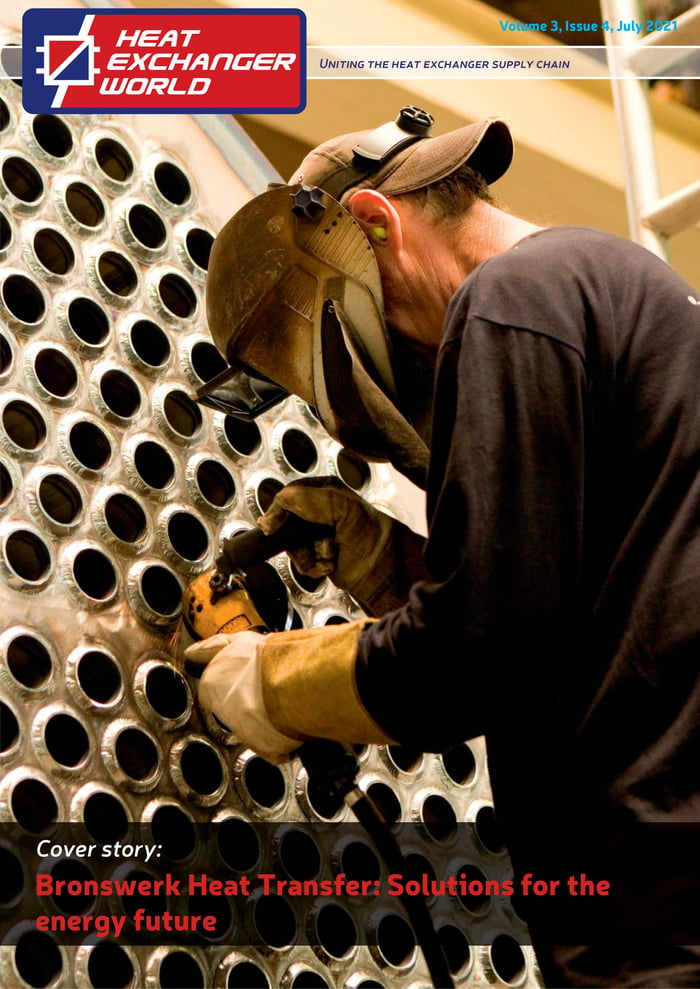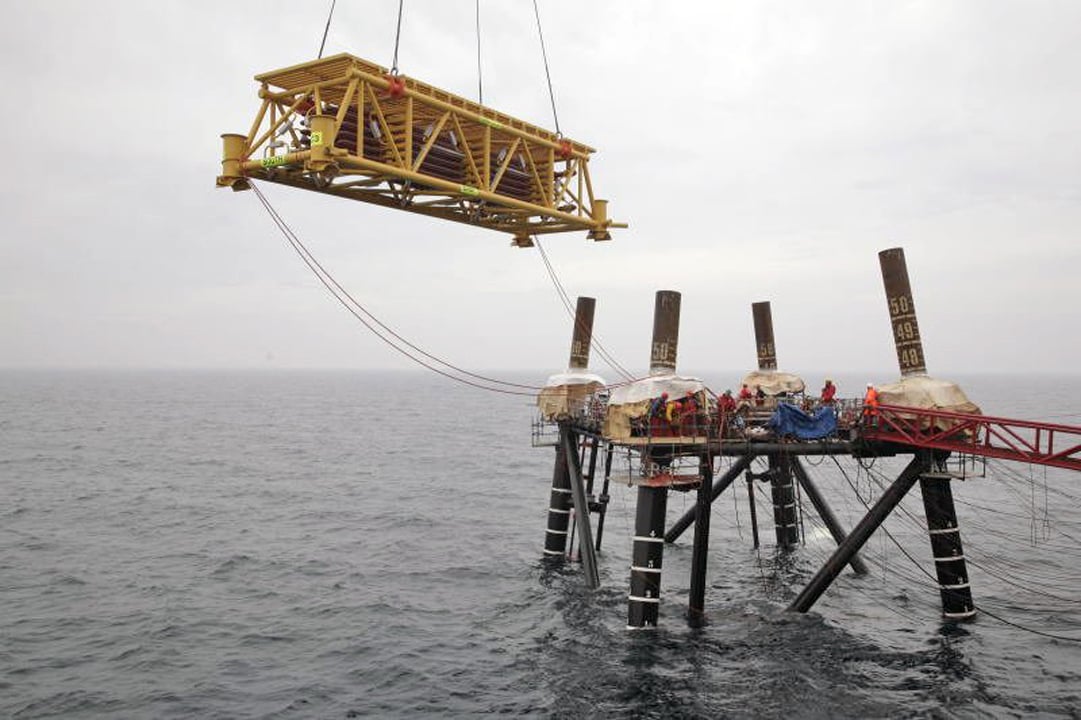Bronswerk Heat Transfer have been manufacturing heat exchange solutions for 81 years. The majority of their back catalogue comprises specialised equipment and custommade solutions, which sets them apart in their competitive market. Managing Director, Ernst-Jan Huijbers, and Operations Director, Jeroen Dekker, about becoming the ‘go-to’ company for challenging heat transfer projects and their expectations of the energy transition.
The Bronswerk reputation
“There are plenty of players in our industry who focus on either production or engineering,” Operations Director Jeroen Dekker begins. “But at Bronswerk, not only do
we manufacture heat exchangers, we also design them.”
Bronswerk offer full package solutions combining thermal engineering, mechanical engineering, production, commissioning, installation, services and maintenance.
Each solution is bespoke; the team works closely with the client at every stage of the process to ensure that the end result is exactly what the situation calls for.
“What we deliver is high quality,” asserts Managing Director Ernst-Jan Huijbers. “What differentiates us is that we mostly work with high-temperature, highpressure equipment. That requires special materials, and we have all the special certifi cations and the experience to design and manufacture those items. To be blunt: customers come to Bronswerk when things get difficult.”
Although the team will readily handle standard issues, their specialisation and indeed their reputation are based on all things unconventional. They are a trusted source
of knowledge and certifi ed skills, and so the Bronswerk reputation has evolved to convey their ability to solve the most challenging dilemmas. Both Ernst-Jan and Jeroen
agree that this is what makes their work so exciting.
The REAC Solid block header
Amongst the company’s extensive product catalogue is the Reactor Effluent Air Cooler (REAC) solid block header. For the oil and gas industry, the REAC is essential for hydroprocessing units, but it is a piece of equipment which is typically vulnerable to constant corrosion from acid water, salts and other components extracted from crude oil. Ernst-Jan explains the challenge in more detail: “It is a charging piece of equipment with a high risk of leakage, meaning also a high risk of explosion. We have developed a solution to minimise the risk of leakage yet remains cost-competitive. That makes it a very interesting product for our clients.”
Bronswerk’s solid block header is a reputable alternative to the standard heat exchange solution, a fabricated product comprising multiple plates and tubes.
“The header of the heat exchanger is the end piece which is traditionally manufactured of multiple steel plates which are welded together,” says Ernst-Jan. “We decided to approach it differently, by creating a solid block of forged metal, which we then machine to fit the pipes – we use the long bore method to create the internal connection of the various chambers. This saves you welding all the plates together. Remember that anything you weld in a heat exchanger is a potential risk, so the less you weld, the lower the risk.”
Jeroen explains that the customer’s confidence in their product is a critical factor: “Minimising the number and total length of welds boosts equipment reliability, which is really important for our customers.
Our REAC solid block header can reduce fear of failure, decrease planned and unplanned downtime due to reduced maintenance, and thus increase plant productivity.”
For Ernst-Jan, this exemplifies Bronswerk’s competitive edge. “This is typical of what we do, we take a holistic view of the wider thermal issue to deliver highly-effective out-of-the-box solutions. Whereas other companies can simply build standard parts, we provide a whole solution.”
The subsea cooler
One example in particular is the subsea cooler. Initially developed in 2009 for a gas company, the Bronswerk subsea cooler is now being adopted by a large energy
company to cool down the transformers of its offshore wind turbines. “We came up with a way to install this equipment in the ocean itself, rather than on the platform. This
saves a lot of space and also benefits from the natural cooling provided by the seawater,” says Ernst-Jan.
The subsea cooler uses the natural convection of the waves to generate its own power, eliminating the need for rotary parts or pumps; in turn, this reduces maintenance significantly, again ideal for unmanned platforms and turbines out at sea. The only remaining issue, which is universal with all subsea equipment, is the biological fouling of sea organisms which accumulate on the equipment and cause wear. Here, too, Bronswerk provide a bespoke solution; throughout the process, the team work closely with the customer to develop cleaning options dependent on the location and depth of the subsea cooler. Options might include in situ cleaning with an unmanned submarine or diver or raising the equipment up to the platform for cleaning instead. Since its initial development in 2009, the Bronswerk subsea cooler has proven popular with energy companies and Ernst-Jan expects solutions such as this to only gain momentum.
Heat recovery solutions
Bronswerk not only forge ahead in terms of case-bycase solutions, they are also being proactive as regards changes in the wider industry. The energy transition may be a point of concern for the entire fl ow control sector; for Bronswerk this is an opportunity for fresh thinking and novel solutions.
Looking at the energy market, Bronswerk have developed various heat recovery solutions for widespread use including in the pulp and paper industry. “There is a lot of heat used in the paper industry to dry out the pulp,” Ernst-Jan explains. “We came up with a system to recover this heat, this energy, and reuse it onsite. The plant can reuse that residual heat as an energy source, such as heating up another medium like water.” This system saves a company both energy resources and money. Ernst-Jan is candid about this latter point: “That’s one of the real challenges for companies in this energy transition; they all want to reduce their CO2 output and waste energy, but there has to be a business case for doing so. Otherwise, the plans will be shelved.”
Data centres and beyond
Jeroen is keen to highlight another sector that Bronswerk is branching into - heat exchange solutions for data centres. Currently, most data centres are air-cooled but, in summer and in hotter environments, an economiser sprays water over the heat exchangers or directly into the air stream. The IT sector is one of the greatest consumers of water; a 1MW data centre reportedly uses up to 25.55 million litres of water per year (Heslin, 2016). Bronswerk has proposed a system which not only
saves water, but also contributes to other industries at the same time.
“To be efficient, a data centre should have some kind of fluid media for cooling the internal equipment,” says Ernst-Jan. “That media can then be transferred and cooled externally with air or, even better, used as a convenient energy source. For example, it can be easily used to heat up greenhouses used to grow crops.”
The team already have one customer in Germany; whilst not a data centre, the infrastructure is similar and the residual heat helps to grow red peppers in a nearby greenhouse. “This constitutes a big saving for greenhouses which typically run up high energy bills when maintaining the optimum temperature and conditions for crops,” Jeroen adds. “By developing technologies that create benefits for multiple businesses, we are providing both a direct solution and also an indirect solution. I believe such an approach will play an essential role as the energy transition progresses.”
A further example of how Bronswerk provide their customers with energy solutions can be found in a large wood energy centre, also in Germany. Here, wood is burnt to generate electricity and also contribute to a district heating network for the nearby city. “This facility emits less CO2 than the brown coal traditionally used,” Ernst-Jan explains. “In this case, we are building air coolers which, when placed behind the turbine, capture energy from the spent steam and use that to regenerate fresh steam. We are also researching the various types of heat exchanger required to distribute heat across the local districts.”
“Impacting on energy where it matters”
As evidenced by recent projects plus the company’s overall path in heat transfer solutions, Bronswerk is not only working towards the energy transition, their
products are in fact part of its progression. Jeroen Dekker and Ernst-Jan Huijbers consider the transition inevitable, but the main focus of their attention is the speed
at which it occurs.
“Just ten years ago electric cars were seen as very expensive and not very practical; nowadays, sales shares of electric cars in the Netherlands have reached 25%,” says Jeroen. “The large-scale transition, however, will happen even faster because we are not talking about individual consumers; we are talking about whole companies who are being reminded of their impact on local environments and communities.” Jeroen again refers to the large-scale data centres which are searching for ways to address energy and water usage.
Reflecting on the recent Dutch court ruling that Shell must reduce its CO2 emissions by 45% within 10 years, Ernst-Jan believes that it is the addition of environmental and sustainability specialists on management boards that will expedite the change. He calls for a realistic viewpoint, however: “Fossil fuels will not disappear for perhaps another 30 years, but there will be a transition to more biofuels and the use of green electricity. All energy sources must be processed, and where there is processing, there is heat exchange; that is good news for us.”
Bronswerk has therefore expanded its range of expertise to ensure they can continue to serve practically all industries. “If we want to use iPhones or drive cars or use bicycles with rubber tyres, then we need a chemical industry. With plastics, even if we find a better way to recycle and produce those plastics, there will still be a need for heat exchange in that process.”
Secure for the sustainable future
Although the future may look uncertain for some sectors as the world strives to transition to renewables and sustainable energy, Bronswerk Heat Transfer
can rest assured in the necessity of its solutions.
“It is very interesting to see where this transition is going,” says Ernst-Jan. “I agree with Jeroen, the speed of the transition is increasing now especially through societal pressure. We are certainly living in interesting times but at Bronswerk we are convinced we can make a substantial and meaningful contribution to a sustainable future in so many of our markets.”
In fact, Jeroen sees opportunities ahead for further business development. “Call it my business instinct, call it an educated guess, but I am certain that whatever new
industrial processes are developed, there will be an opportunity to make use of the waste heat generated by those processes.”
And can Bronswerk offer a solution to make use of this waste energy? “Absolutely,” says Jeroen.

